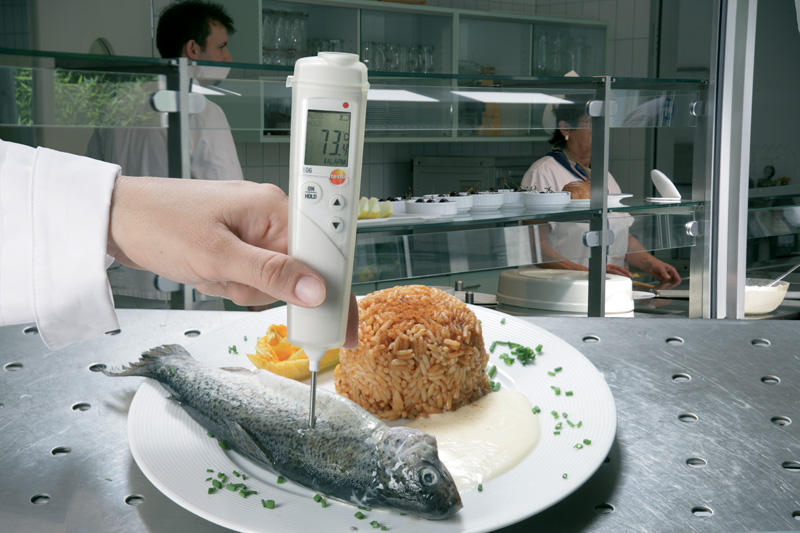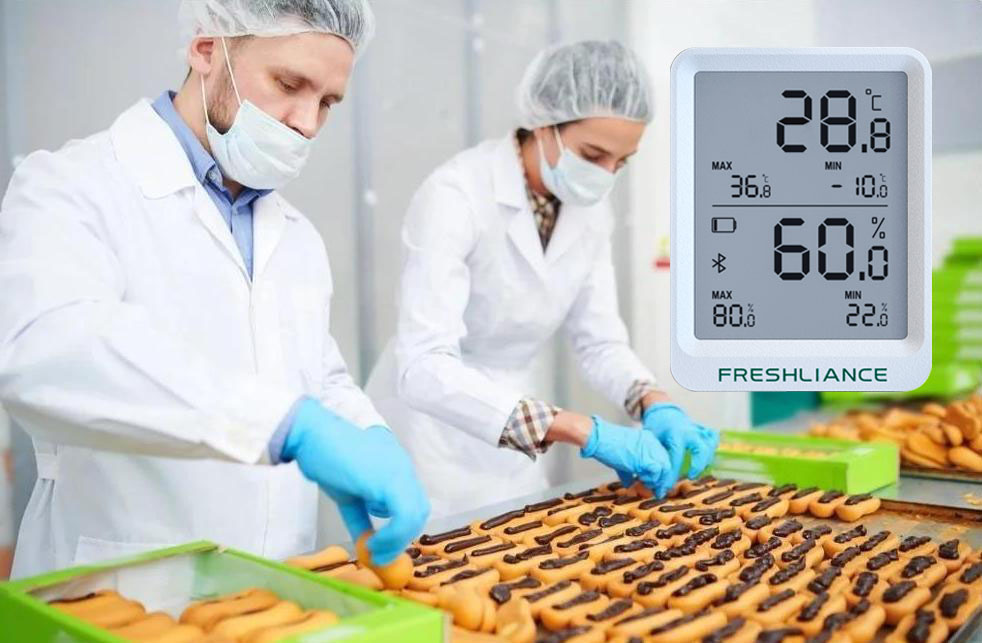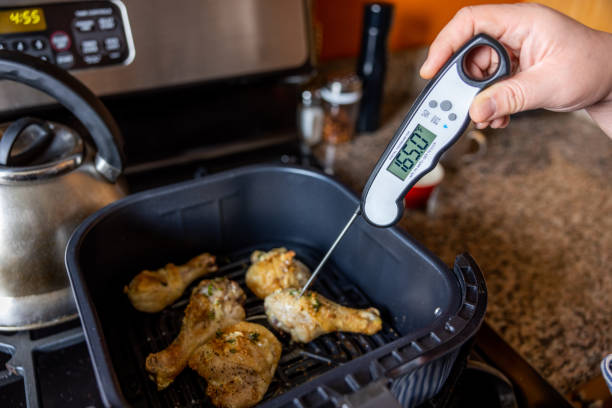What Are Food Temperature Monitoring Devices and Why Are They Essential?
Food temperature monitoring devices are precision instruments designed to measure and track temperature conditions throughout the food supply chain. These essential tools range from basic digital thermometers to sophisticated temperature monitoring sensors and data-logging instruments that provide continuous surveillance of food storage environments.
The primary types include:
- Probe thermometers for spot-checking individual items
- Wireless sensor networks for continuous monitoring
- Data loggers that record temperature fluctuations over time
- Infrared thermometers for non-contact surface measurements
These devices serve as your first line of defence against pathogen growth and spoilage. Bacteria multiply rapidly in the danger zone between 4°C and 60°C, making precise temperature control critical for food safety. When temperatures drift outside safe parameters, harmful microorganisms like Salmonella and E. coli can proliferate to dangerous levels within hours.
Traditional mercury thermometers, whilst accurate, present significant limitations compared to modern solutions. Mercury devices require manual reading, offer no historical data, and pose environmental hazards if broken. Digital thermometers and data-logging instruments provide instant readings, automated alerts, and comprehensive temperature histories. These advanced systems eliminate human error, ensure continuous monitoring even when staff aren’t present, and create the detailed documentation necessary for regulatory compliance and quality assurance programmes.
How Do Food Temperature Monitoring Devices Support Regulatory Compliance?
Food businesses operate within a complex web of regulatory requirements that demand precise temperature documentation. HACCP compliance forms the foundation of food safety management, requiring systematic identification and control of critical control points throughout food handling processes. A food safety thermometer and other monitoring devices serve as the backbone for documenting that refrigeration, cooking, and holding temperatures remain within safe parameters.
The FDA FSMA requirements have elevated the importance of preventive controls and recordkeeping. Under FSMA’s Preventive Controls Rule, you must maintain comprehensive records demonstrating that your temperature monitoring systems function correctly and capture accurate data. This regulation shifts focus from reactive responses to proactive prevention strategies.

21 CFR Part 11 standards govern electronic records and signatures in FDA-regulated industries. Your temperature monitoring systems must meet specific criteria:
- Data integrity: Records cannot be altered without proper authorisation and audit trails
- Access controls: Only authorised personnel can modify or delete temperature data
- Backup systems: Electronic records require secure storage and retrieval capabilities
- Validation protocols: Systems must undergo regular testing to ensure continued accuracy
Calibrated devices, such as a food safety thermometer, represent the cornerstone of regulatory compliance. Uncalibrated thermometers can drift from true readings, creating false confidence in temperature control. Regular calibration certificates provide auditable proof that your monitoring equipment maintains accuracy within acceptable tolerances.s compliance from a paper-based burden into an automated process. Digital systems capture timestamps, user identification, and environmental conditions automatically, creating tamper-evident records that satisfy regulatory scrutiny during inspections.
Read about:Restaurant Temperature Monitoring: Essential Tools for Food Safety
What Features Make Modern Temperature Monitoring Systems Effective?
Modern temperature monitoring systems have transformed food safety management through advanced technological capabilities that surpass traditional monitoring methods.
1. Wireless Sensors for Automated Data Collection
Wireless sensors eliminate the need for manual data collection, automatically capturing temperature readings at predetermined intervals without human intervention. These sensors transmit data seamlessly to centralised systems, reducing the risk of human error and ensuring consistent monitoring coverage across multiple locations.
2. Real-Time Data Transmission for Immediate Alerts
Real-time data transmission enables immediate visibility into temperature conditions throughout your facility. You receive instant notifications when temperatures deviate from safe ranges, allowing for swift corrective action before products become compromised. This immediate response capability proves crucial during equipment failures or power outages when every minute counts in preserving food safety.
3. Cloud-Based Platforms for Flexible Data Management
Cloud-based platforms provide several distinct advantages for modern food operations:
- 24/7 accessibility to temperature data from any internet-connected device
- Automatic data backup preventing loss of critical compliance records
- Scalable storage accommodating growing data requirements without hardware limitations
- Remote monitoring capabilities for multi-site operations
The integration of these technologies creates comprehensive monitoring ecosystems that operate continuously without manual oversight. You can monitor refrigeration units, freezers, and storage areas simultaneously whilst maintaining detailed digital records for regulatory compliance. These systems generate automated reports and maintain historical data trends, enabling you to identify patterns and optimise temperature management protocols across your operations.
How Does Squizify Enhance Food Temperature Monitoring and Compliance?
Squizify compliance solution transforms traditional temperature monitoring through its integrated approach to food safety management. This comprehensive platform combines sophisticated hardware sensors with intelligent software capabilities, creating a seamless ecosystem for Food Temperature Monitoring Devices: Ensuring Accuracy and Compliance across diverse operational environments.
Advanced Hardware Solutions
The system’s hardware solutions include precision temperature monitoring sensors designed for various applications, from cold storage facilities to freight transportation. These sensors integrate directly with Squizify’s cloud-based platform, eliminating manual data entry whilst ensuring continuous monitoring accuracy.
Tailored Monitoring Protocols
Customisable checklists represent a cornerstone feature, allowing you to tailor monitoring protocols to your specific operational requirements. Whether you manage a hospital kitchen, aged care facility, or manufacturing plant, these checklists adapt to your unique compliance needs and regulatory frameworks.
Error-Free Documentation Processes
Automated record keeping capabilities eliminate human error in documentation processes. The system captures temperature data automatically, timestamps entries, and stores records securely in the cloud. This automation ensures you maintain comprehensive audit trails without dedicating staff resources to manual logging tasks.
Real-Time Compliance Visibility
The platform’s auditing capabilities provide real-time visibility into compliance status across multiple locations. You can access detailed reports, identify trends, and demonstrate regulatory adherence through comprehensive documentation that meets HACCP and FSMA requirements.
Secure Remote Monitoring
Squizify’s secure SaaS platform offers 24/7 data accessibility, enabling you to monitor operations remotely whilst maintaining data integrity and security standards essential for food safety compliance.
Why Is Calibration and Personnel Training Critical for Accurate Monitoring?
Regular calibration is essential for ensuring that your temperature monitoring systems are reliable. It involves checking the accuracy of your monitoring devices at specific intervals to ensure they are still measuring within acceptable limits. This is important because temperature sensors can become less accurate over time due to various factors such as changes in the environment, physical wear and tear, or deterioration of electronic components. If you don’t have a proper calibration schedule in place, there’s a risk that you could be getting incorrect readings, which could lead to unsafe food decisions.
Most regulations require that you calibrate your devices at specific intervals, usually every month or every three months, depending on what type of device it is and how often it’s used. Digital thermometers need to be checked using certified reference standards, while wireless sensor networks need to have regular checks done on all their monitoring points.
Training your staff is just as important as calibration when it comes to effective monitoring. Your employees need to know how to properly use the equipment, understand the areas where food may be at risk, and know what actions to take if they get a reading that isn’t safe. Here are some key things that training programmes should focus on:
- How to correctly insert and position thermometers
- How to recognise when an alarm goes off
- How to keep accurate records of temperature readings
- What steps to take if there are problems with the equipment
When your staff are well-trained, they’re more likely to spot potential issues before they become bigger problems that could lead to violations of regulations or unsafe food situations. It’s important to have training that includes both theoretical knowledge and practical experience using the actual equipment you’ll be using for monitoring. Additionally, regular refresher sessions will help ensure that your team stays up-to-date with any changes in procedures and maintains their skills with any new technology being used.
What Risks Arise from Inadequate Food Temperature Monitoring?
Inadequate food temperature monitoring creates severe public health risks that extend far beyond individual businesses. When temperature control fails, pathogenic bacteria like Salmonella, E. coli, and Listeria multiply rapidly, transforming seemingly safe food into dangerous health hazards.
The 2008 Salmonella outbreak linked to peanut products demonstrates these consequences dramatically. Poor temperature monitoring during processing contributed to contamination that sickened over 700 people across 46 states, resulting in nine deaths. The responsible company faced criminal charges, and the incident cost the industry billions in recalls and lost consumer confidence.
Similarly, the 2011 Listeria outbreak connected to cantaloupe processing facilities highlighted how temperature monitoring failures can devastate public health. Inadequate refrigeration and monitoring protocols led to 33 deaths and 147 illnesses, making it one of the deadliest foodborne illness outbreaks in recent history.
Consumer health impacts from temperature monitoring failures include:
- Food poisoning requiring hospitalisation
- Long-term health complications
- Vulnerable populations facing life-threatening consequences
- Widespread community health emergencies
Brand reputation damage proves equally devastating:
- Immediate loss of consumer trust
- Costly product recalls and legal settlements
- Permanent market share erosion
- Regulatory scrutiny and potential closure
The food recall process, which often follows such incidents, underscores the importance of maintaining strict temperature controls. You cannot underestimate how quickly inadequate monitoring transforms operational oversight into public health emergencies. Temperature failures create cascading effects that destroy businesses whilst endangering lives.
Moreover, the long-term consequences of these outbreaks extend beyond immediate health impacts. They can lead to permanent changes in consumer behavior, with affected brands struggling to regain trust even after implementing corrective measures.

How Can Businesses Implement Effective Food Temperature Monitoring Programs?
Building a robust temperature monitoring programme requires strategic integration of technology and documentation practices. You need to establish clear protocols that combine reliable Food Temperature Monitoring Devices: Ensuring Accuracy and Compliance with systematic record-keeping procedures.
Essential Implementation Steps:
- Technology Selection: Choose calibrated digital sensors with wireless connectivity and cloud-based data storage capabilities
- Documentation Framework: Develop standardised checklists and automated logging systems that capture temperature readings, corrective actions, and verification procedures
- Staff Protocols: Create clear procedures for device placement, reading frequency, and response protocols when temperatures fall outside acceptable ranges
- Data Management: Implement secure electronic record-keeping systems that provide audit trails and regulatory compliance documentation
Modern compliance platforms like Squizify streamline this process by offering comprehensive solutions that integrate hardware sensors with automated record-keeping software. You can customise checklists specific to your operational requirements whilst maintaining consistent documentation standards across all monitoring points.
Continuous Support Systems
Implementing 24/7 live chat support ensures you receive immediate assistance when technical issues arise or when staff need guidance on proper monitoring procedures. This continuous support model prevents monitoring gaps that could compromise food safety and helps maintain operational excellence throughout your temperature monitoring programme.
The combination of reliable technology, structured documentation, and ongoing support creates a foundation for sustained compliance and food safety management.
Conclusion
Food Temperature Monitoring Devices: Ensuring Accuracy and Compliance requires a strategic approach that unites cutting-edge technology with comprehensive training and meticulous documentation practices. You cannot achieve operational success through technology alone – your team’s expertise and systematic record-keeping form the foundation of effective food safety management.
Modern solutions like Squizify demonstrate how integrated platforms transform compliance assurance from a reactive burden into a proactive advantage. You gain real-time visibility, automated documentation, and continuous support that adapts to your operational needs.
The investment in advanced temperature monitoring systems pays dividends through reduced risk, streamlined audits, and enhanced consumer trust. You position your business for sustained regulatory adherence whilst protecting both public health and your brand reputation.
Learn about:Restaurant Temperature Monitoring: Essential Tools for Food Safety

